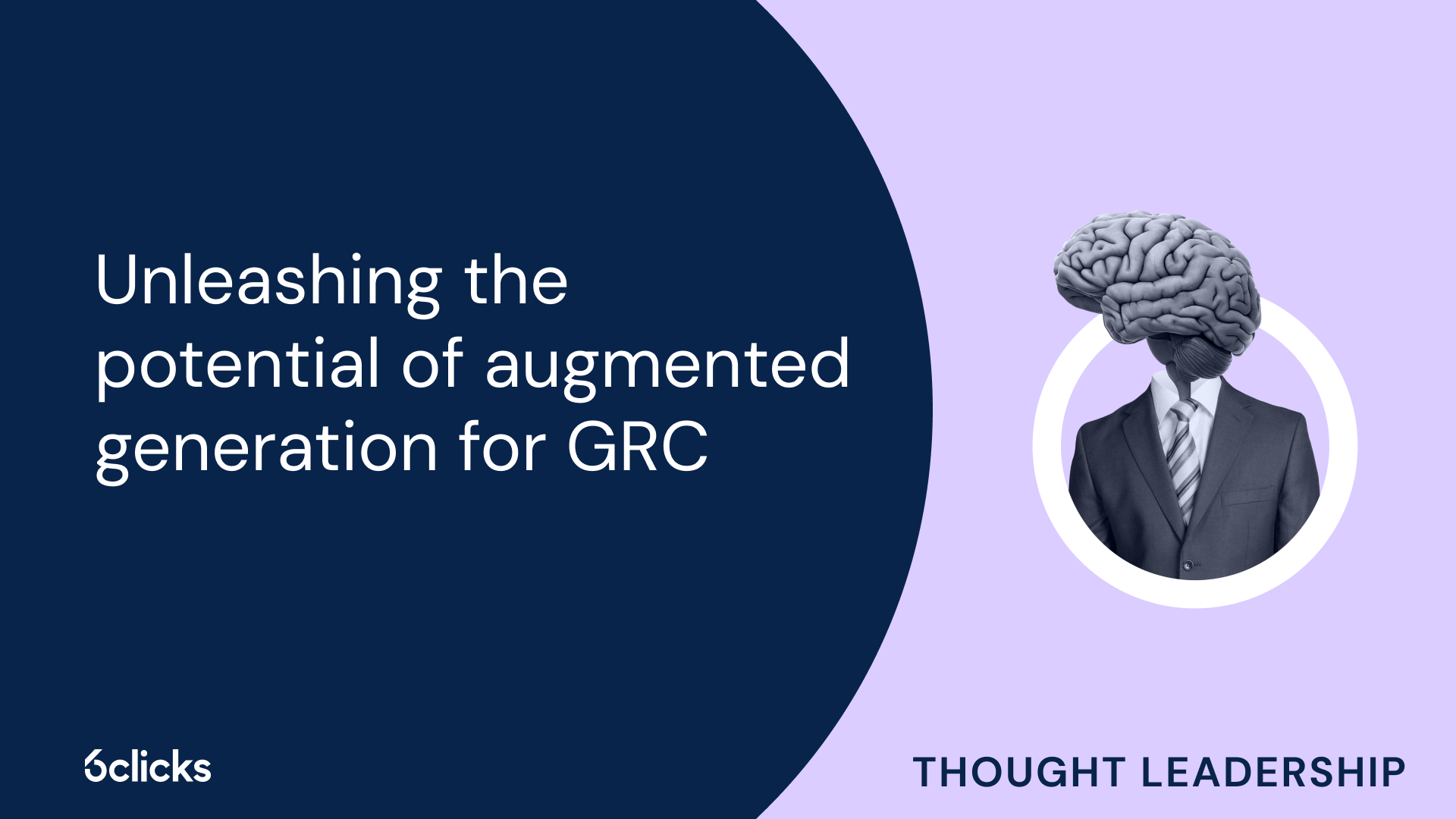
Maintaining data accuracy and protection is a crucial aspect of Governance, Risk, and Compliance (GRC). By integrating data security, privacy, and data quality practices into their GRC strategy, organizations can make better decisions and achieve operational resilience. Recognizing this need for comprehensive data management, we at 6clicks have incorporated augmented generation technology into our GRC solution.
Retrieval-augmented generation or RAG is a promising advancement in natural language processing that can revolutionize organizations’ use of generative AI systems for their GRC processes as it can improve the quality of generated content while preserving data security. Here, we'll learn how 6clicks leverages augmented generation through our AI-powered GRC platform to optimize organizations' risk and compliance activities.
Watch the full interview showcasing Ant Stevens, CEO & Co-Founder of 6clicks, here.
The problem: Ensuring data quality, privacy, and security
In the GRC landscape, data serves as the foundation for making strategic decisions, mitigating risks, and meeting compliance requirements. Effective risk and compliance management involves proper handling of sensitive information, protecting data against unauthorized use and access, and ensuring the accuracy and reliability of datasets, which pose various challenges to organizations. 6clicks has identified a few of these concerns:
Implementing data tenancy
Since organizations carry a vast array of confidential information, they must establish strict controls over who can access and use which data. Data tenancy is the practice of segregating and isolating data based on the clients or tenants to which they belong within a shared environment. It involves implementing technical and operational measures such as access controls that limit the visibility and access of specific data only to authorized users. Data tenancy is essential for organizations to ensure the security, privacy, and regulatory compliance of each of their tenants’ data.
Data sovereignty considerations
Multiple laws and regulations govern the collection, processing, and distribution of data depending on the country in which an organization operates. Data sovereignty enables organizations to adhere to local regulations and effectively manage cross-border data flows and international data-sharing agreements. Organizations must practice data sovereignty to ensure that they can readily access data across different jurisdictions and maintain the continuity of their business activities.
Prioritizing data quality
Poor data quality can make way for flawed decision-making processes and lead to errors, potentially exposing organizations to significant risks and compliance failures. That said, organizations must ensure that data used for tasks such as auditing and compliance monitoring is accurate and up-to-date. With high-quality data, organizations can streamline their GRC operations and reduce unnecessary costs and delays.
Utilizing external data sources
Lastly, harnessing both private and public datasets can help organizations augment their risk and compliance processes. With access to external regulatory data, organizations can keep up with constant regulatory changes and identify gaps to maintain their compliance. It also helps organizations proactively address risks associated with non-compliance.
The journey: Discovering the limitations of Large Language Models
To address the challenge of enhancing data quality, privacy, and security, 6clicks has embarked on a journey to find a robust and scalable solution that can support organizations’ data operations. In our quest, we have found that large language models (LLMs) possess limitations in specific data management contexts.
LLMs are foundation models that are trained on large volumes of data to carry out natural language processing tasks for generative AI systems such as ChatGPT. While LLMs offer valuable applications in content generation and answering queries, they can only provide information based on their training data, which means that they will sometimes respond with random facts and not provide a direct answer to a question.
For example, ChatGPT uses an LLM called GPT-3 (Generative Pre-trained Transformer 3), and its last update was in April 2023. This means that its knowledge is outdated and it will not be able to cite the most recent regulatory information or updates beyond that point. Since it cannot retrieve the latest information, ChatGPT carries the risk of “hallucinations” or generating false information, accidentally.
In the GRC space, an LLM’s hallucinations can come in the form of incorrect predictions or misidentifying threats as more impactful or less impactful than they are, which can have disastrous consequences in the context of risk and compliance.
Moreover, LLMs lack data tenancy capabilities and cannot restrict access and visibility to their training data. They also have a smaller context window which means that they can only translate a limited amount of data into generated text.
Acknowledging how LLMs muddy the waters in data and do not have the capacity for data restrictions and real-time data retrieval, 6clicks came up with the solution using augmented generation to expand the capabilities of LLMs and overcome the data security management challenges faced by organizations.
Our solution: Enhancing compliance management with augmented generation
RAG is an AI framework that improves the quality of responses of LLMs by using advanced retrieval methods to fetch data from external knowledge bases. It is a hybrid model that blends retrieval and generation functionalities which enables LLMs to access accurate and up-to-date information and convert it into a natural language response.

The process of RAG is divided into two stages: retrieval and generation. From the user query, the retriever model uses advanced algorithms to search vast knowledge sources as well as semantic search capabilities to understand the context of the original query and provide the most relevant results. The generator model then combines the retrieved data with the original query for enhanced context and feeds it to the LLM to generate a text response.
By utilizing external, verifiable knowledge sources, RAG prevents LLMs from “hallucinating” or generating misleading information. It also reduces the need for organizations to constantly retrain an LLM on new data, allowing them to reduce computational and financial costs.
Here at 6clicks, we are dedicated to improving the process of data retrieval and content generation through RAG technology, therefore empowering our AI engine called Hailey to produce smarter and more contextually aware responses.
Through our use of RAG, we can solve the data quality, security, and privacy concerns of organizations and streamline their risk and compliance management processes:
- Enhanced data security through query filtering. With RAG, organizations can enforce policies for data access, usage, and sharing, and filter data queries based on data ownership, compliance with privacy regulations, and legal agreements. This allows organizations to comply with data tenancy practices, data sovereignty, and other regulatory requirements, therefore enhancing data privacy, security, and overall compliance with data governance policies.
- Improved data quality through real-time data queries. RAG enables real-time data retrieval and assists AI systems in generating accurate and high-quality content. By providing access to updated laws, regulations, and other external data sources, RAG improves the data quality from which AI systems can create contextually appropriate responses, therefore allowing organizations to utilize timely, relevant, and verified information to help with their risk and compliance activities.
By integrating RAG into our Hailey AI engine, organizations gain confidence in the factual and real-time nature of their GRC data inquiries within the 6clicks app. Hailey accesses the extensive data repositories within the app, employing RAG to retrieve information from the appropriate source and generate precise, referenceable responses. This integration ensures that when users query their GRC data or compliance status, they receive accurate and up-to-date information, in alignment with the dynamic regulatory landscape.
Advantages of augmented generation
Besides providing relevant and up-to-date information, improving generative AI systems, and reducing computational and financial costs, RAG can be used to automate repetitive and time-consuming tasks and enhance efficiency and accuracy in various GRC processes including:
- Reporting. With RAG, compliance professionals can save significant time in creating reports as it allows them to quickly scan through vast amounts of data including regulatory documents, historical data and reports, and internal policies. It can then extract relevant information, analyze patterns, and identify trends to generate comprehensive reports or summaries. By providing valuable insights for decision-making, RAG empowers organizations to make informed choices and adapt to the ever-evolving regulatory landscape.
- Policy analysis. The use of augmented generation promotes consistency and standardization in data analysis. RAG can assist in analyzing and understanding complex regulatory documents, policies, and compliance requirements, helping identify key clauses, obligations, and potential areas of non-compliance. It also helps eliminate biases, reduce the risk of human errors, and ensure that decision-making is based on reliable and objective information. This ultimately leads to more effective risk mitigation and compliance management.
All in all, augmented generation in GRC fosters a culture of innovation and agility within organizations. It encourages the adoption of advanced technologies and enables businesses to leverage data-driven insights for strategic decision-making, ultimately driving competitive advantage and business growth.
The future of augmented generation
Looking ahead, retrieval-augmented generation holds immense potential for GRC. With continuous advancements in AI and natural language processing, the technology is expected to become even more sophisticated and capable of handling complex compliance requirements.
Latest developments include semantic retrieval becoming a crucial component of RAG, which enables organizations to incorporate their data into LLMs by capturing the semantic relationships and meaning embedded within the data. This makes way for more accurate and context-sensitive applications that can further refine generative AI capabilities such as delivering personalized recommendations.
With the increased adoption of LLMs in enterprise settings, RAG technology stands as the best solution to eliminate LLM hallucinations and promote effective AI practices at the organizational level.
Organizations are now also leveraging generative AI to analyze and interpret unstructured data such as chat, videos, and code to train multimodal models, which combine information from diverse data types. This uncovers new opportunities across various sectors, such as healthcare, where multimodal models can analyze patient data from medical records, images, and diagnostic tests to provide personalized treatment recommendations.
This shift from structured data mining is also accompanied by the increasing trend of multimodal LLMs, with organizations using them to innovate on customer experience and foster customer interactions using text, speech, and images. Companies like Meta and OpenAI are also making developments to support additional senses which can lead to advancements in computer vision, natural language processing, and audio processing (NVIDIA, 2024).
Lastly, the integration of augmented generation with other emerging technologies, such as blockchain and Internet of Things (IoT), can further enhance GRC strategies. These technologies can provide additional layers of security and transparency, enabling businesses to build trust and compliance in their operations.
Leverage a cutting-edge solution to risk and compliance management with augmented generation
Improve data management and optimize your risk and compliance processes through advanced information retrieval and content generation. Find out how RAG technology can elevate your GRC program through the 6clicks platform.

